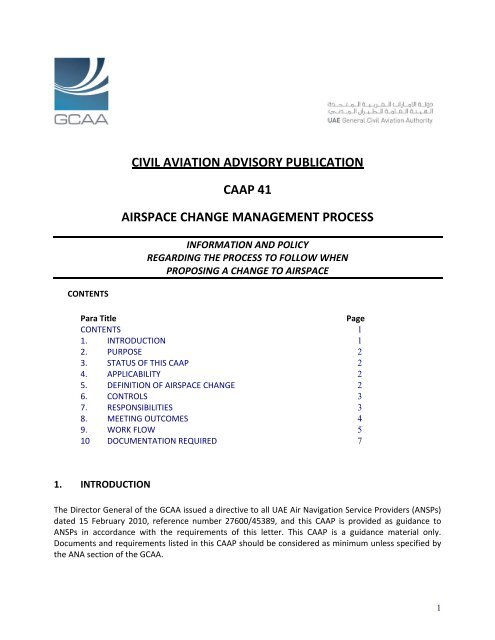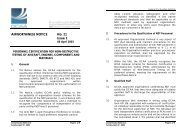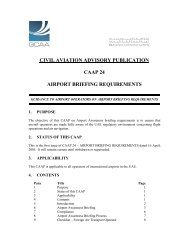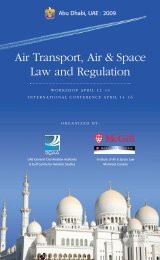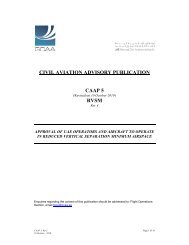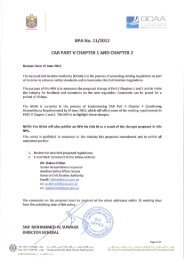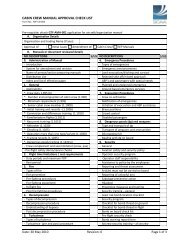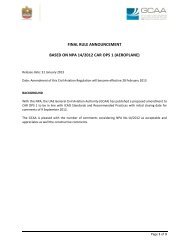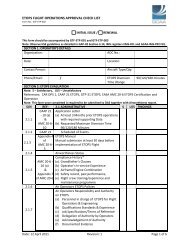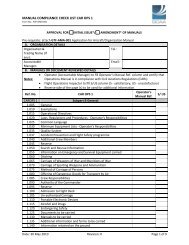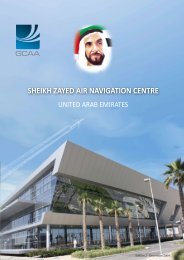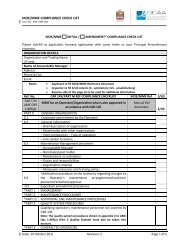civil aviation advisory publication caap 41 airspace change ...
civil aviation advisory publication caap 41 airspace change ...
civil aviation advisory publication caap 41 airspace change ...
- No tags were found...
Create successful ePaper yourself
Turn your PDF publications into a flip-book with our unique Google optimized e-Paper software.
CIVIL AVIATION ADVISORY PUBLICATIONCAAP <strong>41</strong>AIRSPACE CHANGE MANAGEMENT PROCESSINFORMATION AND POLICYREGARDING THE PROCESS TO FOLLOW WHENPROPOSING A CHANGE TO AIRSPACECONTENTSPara TitlePageCONTENTS 11. INTRODUCTION 12. PURPOSE 23. STATUS OF THIS CAAP 24. APPLICABILITY 25. DEFINITION OF AIRSPACE CHANGE 26. CONTROLS 37. RESPONSIBILITIES 38. MEETING OUTCOMES 49. WORK FLOW 510 DOCUMENTATION REQUIRED 71. INTRODUCTIONThe Director General of the GCAA issued a directive to all UAE Air Navigation Service Providers (ANSPs)dated 15 February 2010, reference number 27600/45389, and this CAAP is provided as guidance toANSPs in accordance with the requirements of this letter. This CAAP is a guidance material only.Documents and requirements listed in this CAAP should be considered as minimum unless specified bythe ANA section of the GCAA.1
2. PURPOSEThe purpose of this CAAP is to provide guidance and descriptions to stakeholders wishing to submit aproposal to <strong>change</strong> either <strong>airspace</strong> structure or related operational procedures. For the purpose of thisCAAP, Proponent is defined as “a person, group of persons or organisation with the capability ofproposing <strong>change</strong> to the <strong>airspace</strong> structure.”The CAAP:a) Expands on the letter’s definition of when <strong>change</strong>s to <strong>airspace</strong> are required to be notifiedto the Air Navigation and Aerodromes (ANA) section of the Aviation Security andInfrastructure department,b) Outlines the control documentation against which a proposal shall be assessed,c) Assigns responsibilities to both the Proponent and the ANA section,d) States what work is to be performed and how it should be done,e) Explains the time scale for the review by ANA,f) Details the documentation required from the Proponent,g) Outlines the process to be followed by ANA.3. STATUS OF THIS CAAPThis is the first edition of CAAP <strong>41</strong> and is dated 9 th of August 2010. It will remain current until withdrawnor superseded.4. APPLICABILITYThis guidance CAAP applies to all UAE ANSP’s who have a need to <strong>change</strong> the structure, design or usageof <strong>airspace</strong> with which they have an operational relationship.5. DEFINITION OF AIRSPACE CHANGE5.1 Airspace <strong>change</strong>, for the purposes of this CAAP, is defined as follows:(a) the development of, or <strong>change</strong> to, SID/STAR/Routes/Instrument approach procedures(IAP)/Holding Patterns,(b) Realignment of current CTA/CTR,(c) Delegation of ATS within UAE Airspace to another State or delegation from anotherState to the UAE to provide ATS in portions of their <strong>airspace</strong>,(d) Establishment of, or <strong>change</strong>s to, the lateral or vertical dimensions of Special UseAirspace (SUA), whether temporary or permanent and whether for <strong>civil</strong> or militarypurposes.(e) Development of Visual Reporting Points (VRPs)(f) Change in provision of ATS within a given volume of <strong>airspace</strong>.2
6. CONTROLS6.1 The proposal shall be assessed against the following documents during the assessment process.(a) The UAE Civil Aviation Law and GCAA Law,(b) GCAA CAR Part/s relating to Airspace,(c) UAE Airspace Plan,(d) ICAO Documentation including:i. The Global ATM Operational Concept and,ii. The Global Air Navigation Plan (GANP)6.2 AssessmentProposals shall be assessed by ANA against the above controls during the safety analysisprocess.7. RESPONSIBILITIES7.1 The Proponent is responsible for:(a) Ownership of the proposed <strong>change</strong>,(b) Submitting an ACP form to ANA(c) Identifying the affected stakeholders,(d) Conducting effective consultation on operational and environmental matters,(e) Determining the preferred effective date for the <strong>change</strong>, to allow the appropriate timeline for the regulatory review to be determined.(f) Arranging an exploratory meeting with the ANA section to determine the impact theproposed <strong>change</strong> will have on current <strong>airspace</strong> and usage,(g) Arranging an “initial submission” meeting with the ANA at which the completeddocumentation is presented and a timetable for review is decided,(h) Making any <strong>change</strong>s to the proposal required by the ANA section,(i) Providing additional information/ resources (meetings) as requested by ANA(j) Identifying what 5 letter name codes are required in the proposal, in accordance withthe requirements of Appendix 2 to Annex 11.7.2 The ANA section is responsible for:(a) The <strong>airspace</strong> <strong>change</strong> process(b) Guidance to the proponent on the application of the process, and the need to fulfilloperational, environmental and consultation requirements(c) Scrutinizing the proposal against regulatory requirements(d) Determining who will review the proposal(e) Making transparent and accountable decision making3
(f) Fulfilling statutory requirements with respect to <strong>airspace</strong>.(g) Director of Aviation Security & Infrastructure is responsible for final sign‐off either approvingor rejecting the proposal7.3 The ANA Project Leader is responsible for:(a) Acting as the focal point for all correspondence with the Proponent,(b) Compiling all elements of the assessment,(c) Ensuring guidance is provided as required to the Proponent.8. MEETING OUTCOMES8.1 The Exploratory Meeting shall:(a) Determine the feasibility of the proposal,(b) Determine the degree of safety analysis to be carried out by assessing the size and safetymagnitude of the proposal, categorizing it as Minor, Moderate or Major.i. Minor would require the least amount of supporting documentation andconsultation, both of which would be agreed at the exploratory meeting.ii.Moderate would require at least a safety assessment from the Proponent containingdetails of:a. Actions required,b. the scope of the <strong>change</strong>,c. the assumptions made,d. responsible personse. consultation activitiesf. safety assurance actionsg. training requirementsiii. Major would require a safety assessment from the Proponent supporting theproposal consisting of :a. A complete record of the analysis performed showing what was done, bywhom and when.b. The operational content will be similar to the items required in the safetystatement, validating the assumptions made and recording the outcomes ofthe safety assurance processes such as a HAZID or similar analysis.c. A cost benefit analysis / impact assessmentd. A proposed time for a post implementation review to take place (within 12months of implementation.)(c) Determine the scope and degree of consultation required,(d) Determine the documentation required from the Proponent.8.2 The Initial Submission Meeting shall:4
(a) Receive the proposal for completeness review,(b) Determine the time scale required for the regulatory review of the proposal,(c) Determine the reporting interval for progress reports to the Proponent,8.3 Subsequent submission meetings shall be held as required. If the completeness check requiresfurther information from the Proponent, this shall be submitted and accepted before the safetyassessment can commence9. WORK FLOW9.1 The work flow described below is predicated by the AIRAC cycle submission cut‐off date requiredfor the effective date preferred by the proponent and the complexity of the proposal. ANA finalapproval / rejection will be notified not less than 5 working days prior to AIS cut‐off date. Theproposal works back from the AIS cut‐off date.Phase 1Phase 2Phase 3Phase 4Phase 5Phase 6Exploratory meeting at which proposal is discussed, Stakeholdersidentified, documentation required and time scale agreed.The period of proposal development, consultation and document collationin preparation for final submission of the proposal.Submission of proposal for completeness check. The time required for thisphase will be discussed and agreed during the exploratory meeting.Safety Assessment. A minimum of 10 working days is required for theassessment of IAPs. More time is required for more complex proposalsand the time requirement would be discussed and agreed at the initialsubmission meeting.Acceptance or rejection of the proposal by the Director of AviationSecurity and Infrastructure.Submission cut‐off date.5
10 DOCUMENTATION REQUIRED10.1 Documentation requirements shall be set at the exploratory meeting and shall consist of someor all of the following elements:(a) Exploratory Meeting:i. A list of all stakeholders to be consulted and the planned consultation process. TheGCAA may require additional stakeholders be consulted.ii.iii.A justification for the <strong>change</strong> proposed which should contain an explanation of theproposed <strong>change</strong> and why it is required.An analysis of the options available to the Proponent. The options, including retainingthe status quo, should all be identified and a justification provided as to why aparticular option was not continued with.(b) Initial Submission meeting:i. A correctly filled ACP form (Attached to this CAAP and soon to be on GCAA Website)ii. A description of the proposed <strong>airspace</strong> both written and graphical showing both thecurrent <strong>airspace</strong> and the proposed <strong>change</strong>s. The description should include:a. The type of route or <strong>airspace</strong>; eg airway, CTR, SID etc.b. The hours of operation if not H24,c. Connectivity with adjacent <strong>airspace</strong> or route structure,d. Supporting information on traffic levels both present and forecast,e. Evidence of draft LoAs or MoUs with affected ANSPs including anyrequirements from the consultation process,f. Evidence that the proposal is compliant with ICAO SARPs and UAE <strong>airspace</strong>policy and regulatory requirements (when developed)g. The proposed <strong>airspace</strong> classification,h. Evidence that the proponent can provide the resources required to operatethe <strong>airspace</strong> effectively,i. Details of and justification for any delegation of ATS responsibility for the<strong>airspace</strong>.iii.Evidence of infrastructure supporting the proposal including:a. CNS facilities required,b. Contingency provisionsc. SSR code allocation requirementsd. 5LNC requirementsiv.An assessment of the operational impact of the proposal on <strong>airspace</strong> users includingthe effect on general <strong>aviation</strong>, military traffic and airports.v. An assessment of the economic benefit/cost involved for stakeholders,7
vi.vii.viii.ix.A safety assessment of the proposed <strong>change</strong>, either by the Proponent or jointly withother affected stakeholders,A statement that the proposal does or does not comply with the UAE Airspace Plan(when finalised) and a justification in the event that it does not comply.An examiner should be flexible to the possibility of <strong>change</strong>s arising to pre‐flight briefsdue to ATC instructions, or other circumstances affecting the test/check.Evidence that the proposal:a. Contains normal operation of aircraft within controlled <strong>airspace</strong>,b. Meets ATM system requirements including the interfaces with adjacent<strong>airspace</strong> ATM systems,c. Allows maximum access to as many classes of <strong>airspace</strong> users as can behandled efficiently but limits unauthorised incursions,d. Shall be promulgated according to the AIRAC cycle,x. An assessment of the environmental impact of the proposal,xi.xii.Draft LoAs, MoUs and AIP entries for acceptance by ANA,The final, signed LoA or MoU will need to be provided to the ANA section prior to thecompletion of the proposal assessment period, i.e. at least 6 working days prior tothe AIS submission cut‐off date so that it can be available before the Director ASDIsigns the proposal as accepted.Evidence of the consultation carried out and the outcome of the consultation.All supporting documentation shall be provided in formats and media acceptable to the Authority.8
GCAA/DASI/ANA Section Airspace Change Proposal FormRESTRICTED - MANAGEMENT (WHEN COMPLETED)Airspace Change Proposal FormANY ANSP/ AUTHORITY IS TO COMPLETE THIS FORM PRIOR TO SUBMITTING ANY AIRSPACE CHANGEDOCUMENTATION REQUEST. BEFORE COMPLETING THIS FORM, PLEASE REFER TO CAAP <strong>41</strong> FOR GUIDANCEGUIDANCE NOTES FOR COMPLETION THE FORM1. When completing this form it is not necessary to duplicate large areas of other manuals; but provide fullreference so answers can be easily found.2. When completing the form, the computerised form should allow each answer box to expand to accept ananswer of any length.3. If proposing authority considers any particular questions of the form do not apply to their proposal, theyshould state this in the space provided for the answer4. Queries relating to the completion of this should be directed to GCAA ANA section.5. All the documents required by GCAA ANA listed in CAAP <strong>41</strong> should be submitted as attachements to the form.1. Contact Detailsa) Name and Address of Proponent:Telephone No:Fax No:Web Site:b) Name and Address of Focal Point Person:Telephone No:Fax No:Email:c) Name and address of Procedures Designer:Telephone No:Fax No:Email:2. Submission Details2.1 Is this a temporary or permanent <strong>change</strong>? Elaborate please2.2 What is the purpose of the <strong>change</strong>?GCAA/DASI/ ANA Section 1Version 1 AUG 2010
GCAA/DASI/ANA Section Airspace Change Proposal Form2.3 a) Has the consultation with the stakeholders carried out?b) If yes, list the stakeholders that were consulted and the means of consultationc) Show outcome/s of consultation and whether incorporated into proposal or not.2.4 Has an impact assessment (operationally and environmentally) carried out? Elaborate please if necessary2.5 Have the procedures been quality checked?2.6 Is this a recurring activity? (Elaborate please)2..7 Are all the documents required by GCAA ANA listed in CAAP <strong>41</strong> ready for submission?2.8 What is the requested AIRAC cycle for the proposal?GCAA/DASI/ ANA Section 2Version 1 AUG 2010
GCAA/DASI/ANA Section Airspace Change Proposal Form2.9 Please give a brief description about the proposalName of proponent:………………………………………………………………………………Signature:………………………………………………………………………………………….Date:……………………………………………………………………………… …………..GCAA/DASI/ ANA Section 3Version 1 AUG 2010


